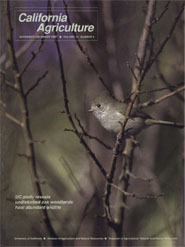All Issues

UC study reveals undisturbed oak woodlands host abundant wildlife
Cover:
The plain titmouse is one of many species inhabitating oak woodlands. Removal of understory vegetation and downed woody material for development, grazing, wood cutting, row croping and road building has altered much of that habitat statewide. UC scientists have assessed the diversity and abundance of wildlife in some relatvely unaltered oak woodlands at Camp Roberts. The data will be used to evaluate the effects of oak woodland disturbances on animals... Photo by B. Moose Peterson
November-December 1997
Volume 51, Number 6
Volume 51, Number 6





